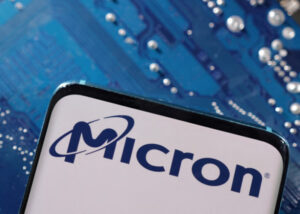Micron Technology Faces Market Whiplash Amidst AI Chip Demand Surge
On Thursday, Micron Technology, Inc. (MU) saw its stock nose-dive by over 17%, a response to its disappointing guidance for the upcoming quarter despite an apparent boom in demand for artificial intelligence (AI) semiconductors. This dramatic shift underscores the knife-edge balancing act faced by chip manufacturers in the current tech ecosystem.
Micron’s forecast estimated revenue between $7.7 billion and $8.1 billion for the quarter, a far cry from Wall Street’s anticipations hovering around $9 billion, according to Bloomberg’s consensus estimates. This misalignment reflects a broader trend gripping the semiconductor industry: while AI-related chip sales are on a meteoric rise, traditional chip markets, particularly for personal computing devices, are seeing a significant downturn.
It’s noteworthy that Micron’s high bandwidth memory (HBM) chips are crucial elements in Nvidia’s cutting-edge Blackwell GPUs, integral to data centers operated by hyperscale cloud providers. Indeed, the demand for these GPUs is projected to surge over the next year, promising a vital revenue stream for Micron. Yet, the company cannot entirely insulate itself from the weak consumer chip market.
In a recent statement, Micron’s CEO, Sanjay Mehrotra, revealed that for the first time, revenue generated from data centers has surged to over 50% of the company’s total revenue for the fiscal quarter ending November 28. However, the pain point remains in their consumer-focused sectors, which are presently underperforming. Specifically, while sales of HBM chips have skyrocketed by 50% in the latest quarter, revenue from mobile phone chips has plummeted by 19%.
As analysts circle, the sentiment on Wall Street has begun to shift. Bank of America’s Vivek Arya downgraded Micron from Buy to Neutral, articulating that even the booming revenue tied to AI chips isn’t sufficient to counterbalance the demands of a flagging PC market. Other institutional voices, including those from JPMorgan, Raymond James, and TD Cowen, have similarly revised their price targets downward while maintaining positive outlooks on the stock.
However, it’s not all doom and gloom for Micron. While the current demand for PC-related chips is languishing longer than projected, the emerging opportunities in the AI sector are on a robust trajectory. Micron forecasts that the HBM market could balloon to $30 billion by 2025, up from an earlier estimate of $25 billion. In parallel, the company projects its HBM revenue could leap from several hundred million in fiscal year 2024 to potentially several billion in 2025.
Analyst Krish Sankar from TD Cowen commented on the stock’s dip, suggesting that the reaction post-results was unexpected given existing knowledge regarding the weak memory pricing landscape. Despite lowering his price target from $135 to $125, he has retained his Buy rating, signaling confidence in Micron’s long-term potential.
In summary, while Micron Technology grapples with immediate cracks in its traditional markets, the company’s strategic positioning in the booming AI sector could serve as a significant catalyst for recovery and growth. Investors looking to stay ahead of the curve would do well to keep a close watch on Micron’s evolving relationship with AI technology, which may very well be the key to unlocking substantial future value.

